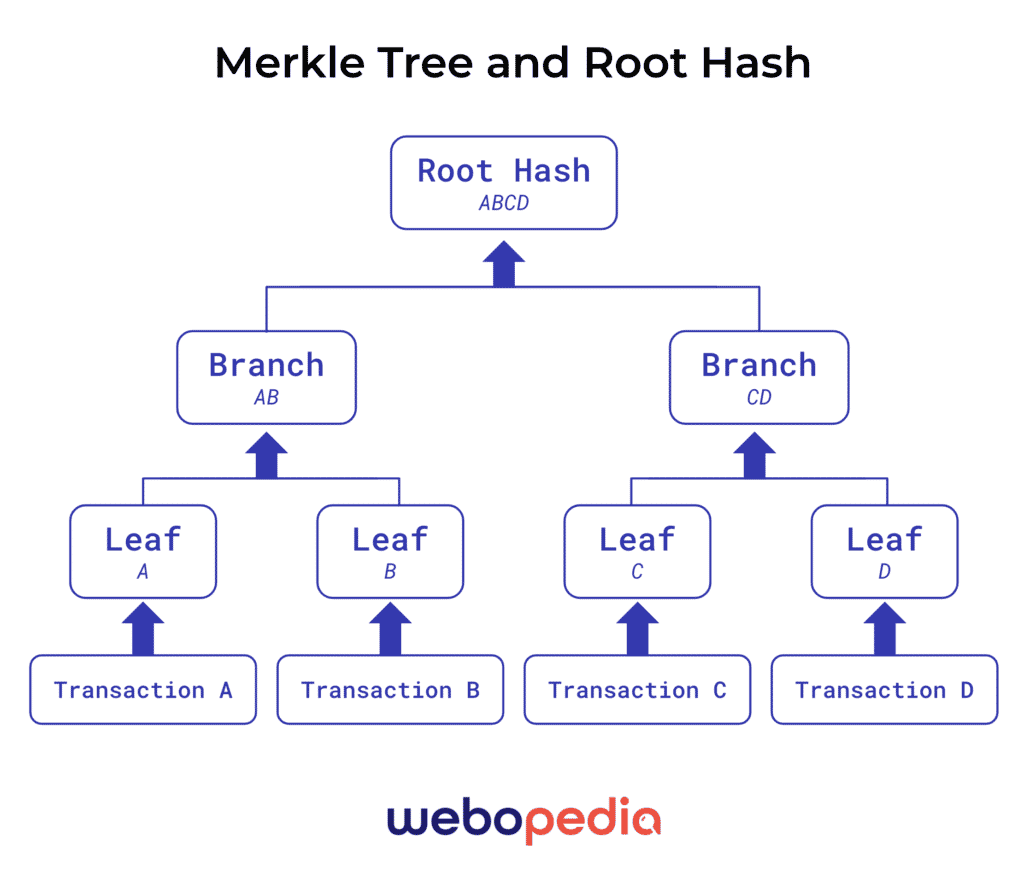Merkle trees and Merkle proofs are important concepts in the world of blockchain technology. They allow for the efficient verification of large amounts of data and enable privacy-preserving applications of blockchain technology.
What is a Merkle Tree?
A Merkle tree, also known as a hash tree, is a data structure used in blockchain technology to verify the integrity of large amounts of data efficiently. It is also used to store transactions in a secure and efficient manner.
Merkle tree is named after Ralph Merkle, who patented the concept in 1979.
A Merkle tree consists of a series of hashes arranged in a binary tree structure. Each non-leaf node in the tree is the hash of its two child nodes. The hashes at the bottom of the tree, known as the “leaves,” represent the data being hashed, such as transactions in a blockchain. The top hash of the tree is known as the “root” of the tree.
When a node wants to verify the integrity of the data in the block, it can do so by simply calculating the hash of the transactions and comparing it to the root hash in the block header. If the calculated hash matches the root hash, it can be reasonably assumed that the data has not been tampered with.

The use of a Merkle tree allows for efficient and secure verification of the transactions contained in a block. When a new block is added to the blockchain, only the Merkle root needs to be transmitted, rather than the entire list of transactions. This allows for more efficient communication and reduces the amount of data that needs to be transmitted and stored.
Merkle trees have a number of useful properties in the context of blockchain technology:
- They allow for efficient verification of large amounts of data, as only the root hash needs to be transmitted and stored.
- They also enable “Merkle proofs,” which allow a node to prove that a specific transaction is included in the block without revealing the entire contents of the block. This can be useful for privacy-preserving applications of blockchain technology.
There are many use cases for Merkle trees in blockchain technology, including cryptocurrency transactions, supply chain management, and identity verification.
What is a Merkle Proof?
A Merkle proof, also known as a Merkle inclusion proof or a Merkle path, is a small piece of data that can be used to prove that a specific transaction is included in a block in a blockchain. It consists of the hashes of the transaction and its siblings in the Merkle tree, as well as a pointer to the position of the transaction in the tree.
To verify a Merkle proof, a node can use the hashes and pointers contained in the proof to recreate the Merkle tree and check that the transaction is indeed included in the tree. This can be done without revealing the contents of the other transactions in the block.
Merkle proofs are useful in several contexts. For example:
- They can be used to prove that a specific transaction is included in a block without revealing the contents of the other transactions in the block, which can be useful for privacy-preserving applications of blockchain technology.
- They can also be used to efficiently verify the inclusion of a large number of transactions in a block, as only the proof for a single transaction needs to be transmitted and stored, rather than the entire contents of the block.
Benefits of Merkle Tree and Merkle Proof
There are several benefits to using a Merkle tree and Merkle proof in blockchain technology:
- Efficient verification: A Merkle tree allows for the efficient verification of large amounts of data. Only the root hash of the tree needs to be transmitted and stored, rather than the entire contents of the block.
- Privacy-preserving: A Merkle proof allows a node to prove that a specific transaction is included in a block without revealing the contents of the other transactions in the block. This can be useful for privacy-preserving applications of blockchain technology.
- Tamper-evident: The use of a Merkle tree in a blockchain makes it difficult for an attacker to tamper with the data in the block without being detected. This is because any changes to the data will result in a different root hash, which can be easily detected by comparing the calculated root hash to the root hash stored in the block header.
- Scalability: A Merkle tree allows for the efficient inclusion of a large number of transactions in a block, as only the root hash needs to be stored in the block header. This can improve the scalability of the blockchain.
- Lightweight: A Merkle proof is a small piece of data that can be transmitted and stored efficiently, making it suitable for use in lightweight applications.
Overall, the use of a Merkle tree and Merkle proof in blockchain technology enables efficient verification of large amounts of data, enables privacy-preserving applications, and helps to improve the scalability and security of the blockchain.
Next Steps — Implementation
You have a lot of options to implement Merkle Proof in your blockchain apps — Build the Merkle Tree smart contracts from scratch or use a smart contract template from Bunzz.

The Merkle Proof smart contract template on Bunzz allows you to verify whether single or multiple leaves exist on the Merkle Tree or not. It’s a wrapper contract based on OpenZeppelin’s MerkleProof library.
You can access this smart contract and the code here.

The MerkleTokenVesting smart contract template on Bunzz contains two main functionalities:
- TokenVesting that vests the balance of any ERC20 token to beneficiaries
- Verify the beneficiary through a Merkle tree.
You can access this smart contract and the code here.
Want to Connect? If you follow these steps and got stuck, or if you have any questions, feel free to reach out on Discord or send me a DM on Twitter.







